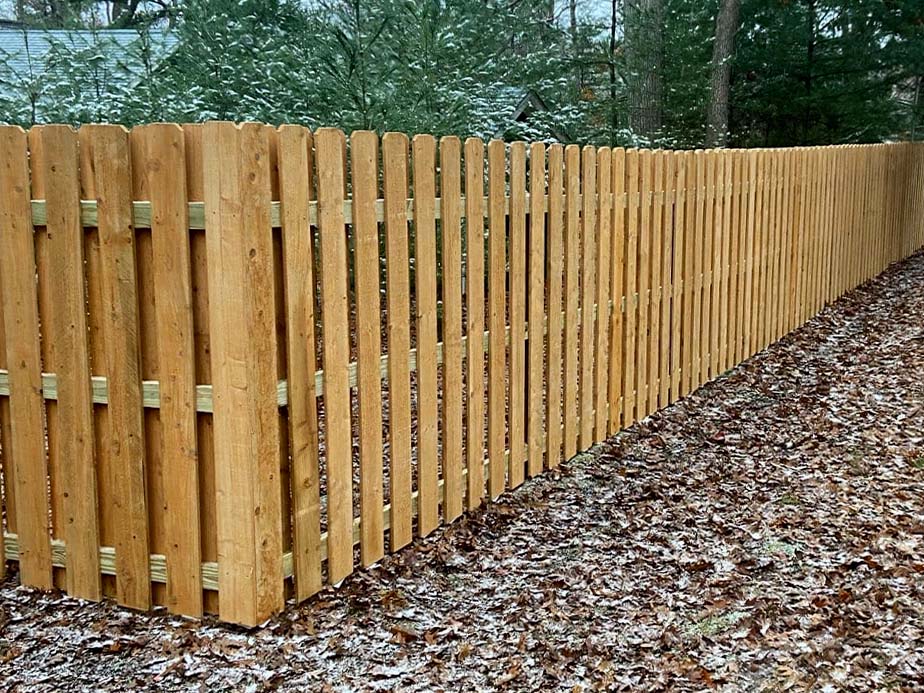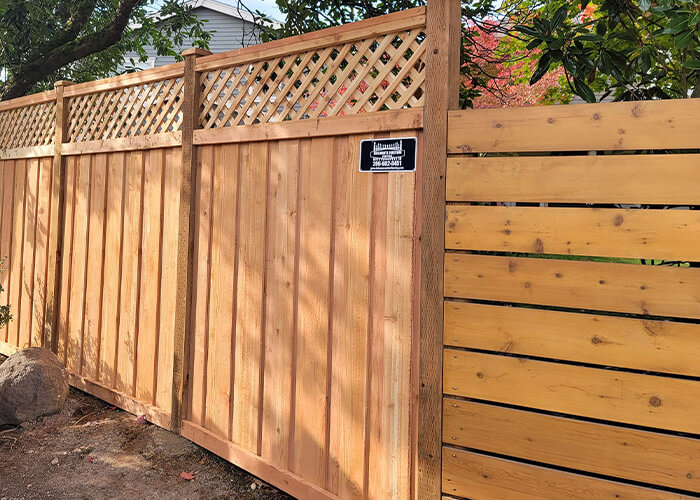How to Recognize Typical Issues That Need Immediate Fencing Repair
It is essential to detect problems before they end up being bigger issues when it comes to maintaining your fencing. Frequently examining for indicators of decaying timber, leaning panels, or corrosion can conserve you time and money in the lengthy run. You could not realize how climate and bugs can compromise your fence's stability. Allow's explore the common signs that suggest your fencing requires instant interest, so you can maintain your property safe and secure and looking its finest.
Signs of Rotting Wood in Wooden Fences
Have you discovered your wooden fencing looking a bit worse for wear? If so, it may be time to inspect for indications of deteriorating timber. Examine the base of the articles and panels for soft places. That's a clear indicator of rot if you push on the timber and it feels squishy or collapses. Next off, try to find discoloration or dark areas on the timber-- these commonly signal dampness damage. Focus on any peeling off paint or coating, as this can subject the wood to more degeneration. Furthermore, a pungent, musty scent can suggest fungal growth. Do not fail to remember to check connections and joints; if they're loosened or breaking down, the wood underneath is most likely endangered. By catching these signs early, you can avoid a lot more extensive damages and keep your fence standing strong. Regular upkeep is vital to prolonging the life of your wooden fence.
Leaning or Tilting Fencing Panels
If you've noticed your fencing panels turning or leaning, it's critical to recognize what triggered it. This problem could show underlying structural damage that requires your focus. Let's explore the common causes and the repair choices offered to get your fence back fit.

Causes of Leaning Panels
It's often a sign of underlying concerns that need attending to when you notice your fencing panels turning or leaning. One usual cause is poor drain; too much water can erode the dirt around the fencing posts, deteriorating their assistance. One more culprit could be strong winds or tornados that push against the panels, specifically if they're not correctly anchored. In addition, the all-natural settling of soil gradually can create articles to shift, bring about a tilt. Parasites, like termites, can jeopardize the integrity of wooden panels, creating them to lean. Lastly, poor installment methods might result in panels not being safely set, leaving them susceptible to leaning under pressure. Address these problems promptly to maintain your fence's stability.
Signs of Architectural Damage
Seeing turning or leaning fencing panels can be startling, as these concerns frequently indicate architectural damages that requires prompt focus. When your fence starts to lean, it might signal that the posts are moving or that the dirt around them has actually deteriorated. Pay attention to gaps between panels or blog posts, as these can likewise recommend instability. deck builder. Additionally, check for fractures or splintering in the timber, which can damage the general framework. It could compromise the integrity of the fence if you notice corrosion or rust on steel components. Remember, ignoring these indications can lead to a lot more extreme damage down the line, so it's necessary to examine the scenario promptly and take action prior to it aggravates
Repair Work Options Available

Rust and Corrosion in Metal Fences
If you own a steel fencing, you could notice corrosion and deterioration creeping in in time, particularly if it's subjected to moisture. These concerns not only affect the look of your fencing yet can likewise endanger its structural stability. To recognize rust, seek reddish-brown places or patches, which indicate the steel is oxidizing. Deterioration can spread out quickly if left neglected, leading and compromising the fencing to costly repairs.To deal with rust and rust, you should cleanse the influenced locations with a cable brush and use a rust-inhibiting primer. Once the guide dries, take into consideration repainting the fencing with a weather-resistant paint to protect it further. Regular maintenance, such as examining for indications of corrosion and repairing paint as needed, will certainly assist extend your fence's life-span. Attending to these concerns without delay ensures your metal fence click here for more info remains strong and aesthetically appealing for many years ahead.
Splits and Splits in Vinyl Secure Fencing

Reasons For Plastic Damage
Vinyl secure fencing is popular for its toughness, yet it can still experience splits and divides because of numerous elements. One significant reason is severe temperature level fluctuations. It can weaken the product over time when plastic broadens in the heat and contracts in the cool. In addition, direct exposure to rough sunshine can lead to UV degradation, making the vinyl breakable. Physical impacts, like hefty branches or accidental accidents, can additionally produce cracks. Poor setup or making use of low-quality materials can worsen these concerns. Age plays a duty; older vinyl secure fencing is more vulnerable to damages. Regular assessments can help you identify these aspects before they bring about significant issues. Take proactive procedures to assure your fence continues to be intact and solid.
Fixing Cracks Successfully
Although cracks and splits in your vinyl fence can be worrying, addressing them without delay can prevent further damage and maintain the fence's appearance. Assess the dimension of the split. For tiny fractures, a plastic repair work kit usually consists of sticky that can bond the edges, supplying a seamless repair. Clean the area completely before applying the glue, guaranteeing it sticks properly. For bigger divides, you might need to utilize a vinyl spot. Cut the check my source spot to size, apply adhesive around the edges, and press it securely onto the split. Enable it to heal according to the manufacturer's directions. Regular upkeep and quick fixings can extend your fence's life-span, keeping it looking great for years to come.
Loosened or Missing Out On Fence Messages
Loosened or absent fencing messages can undermine the security of your entire fencing structure. If you see any kind of posts tottering or leaning, it's necessary to deal with the issue right away. Inspect for any kind of indicators of activity, as this can lead to additional damage gradually. You can quickly evaluate the trouble by providing each article a gentle shake-- if it really feels unstable, it's time to take action.For missing blog posts, you'll require to replace them immediately to keep your fencing's stability. When you set up brand-new articles, make certain they're firmly secured in the ground with concrete or gravel for included stability. If a message is loosened, tighten it by including additional assistance or driving it deeper right into the ground.Ignoring these concerns can lead to larger issues, like gaps in your fencing and even complete collapse. Keep an eye on your articles and stay aggressive concerning repair work!
Damages From Weather Condition and Natural Elements
Climate and all-natural aspects can ruin your fencing, leading to various types of damage that require punctual attention. Hefty rain can cause timber to read here rot, making it unstable and weak. Snow buildup may flex or break panels, while strong winds can root out fence blog posts or trigger sections to lean.If you see splits or splintering in wood fencings, it's a sign of drying because of intense sun exposure. On the other hand, metal fences can rust if protective finishings wear away, particularly in coastal or humid areas.Inspect your fencing routinely after tornados or severe climate to catch any type of damages early. Attending to these concerns swiftly can save you from costly repair work down the line. Do not wait until a little issue transforms right into a major one; remain positive and keep your fencing in leading form to preserve both functionality and curb appeal.
Parasite Invasion and Termite Damage
When you discover indicators of insect problem or termite damage, it's important to act swiftly to prevent further destruction. Seek mud tubes along your fencing or hollow-sounding timber, as these show termites go to job. You might also see small holes or frass, which is termite droppings appearing like sawdust. If you identify any of these signs, it's time to evaluate the damage.Don' t wait up until it's too late; bugs can endanger your fencing's stability. Inspect the surrounding location for ants or beetles, as they may be contributing to the problem. If you suspect an invasion, think about speaking to an insect control professional to confirm and deal with the issue.Repairing or changing affected areas of your fencing promptly not only restores its toughness but likewise avoids pests from spreading out better. Stay vigilant to maintain your property pest-free and secure.
Regularly Asked Inquiries
Exactly how Commonly Should I Check My Fence for Damages?
You ought to evaluate your fence at the very least twice a year, preferably during springtime and fall. Regular checks aid you find damage early, conserving you money and time on repair services while preserving your building's appearance and protection.
Can I Fix a Fence Myself or Employ a Specialist?
If you have the right devices and skills, you can certainly repair a fence on your own. Working with an expert warranties quality work and saves you time, particularly for complicated repair services or substantial damages.
What Tools Are Required for Basic Fencing Repairs?
For standard fencing fixings, you'll need devices like a hammer, screwdriver, pliers, a saw, a level, and measuring tape. deck builder. Relying on the fixing, you might likewise require nails, screws, or substitute boards
Just How Much Does Fence Repair Service Commonly Expense?
Fencing repair service prices differ widely, however you can anticipate to pay in between $200 and $1,500 depending upon materials, labor, and extent of damages. It's wise to obtain several quotes for the very best deal.
When Is the very best Time of Year for Fence Repairs?
The most effective time for fence fixings is during light climate, normally in spring or very early loss. You'll stay clear of extreme temperature levels, making it easier to function and making certain the products established effectively for lasting resilience (deck builder). Discovering leaning or tilting fencing panels can be worrying, as these issues typically indicate structural damage that needs instant attention. Loosened or absent fencing articles can threaten the stability of your whole fencing framework. Snow accumulation could bend or break panels, while strong winds can root out fence posts or create sections to lean.If you see splits or splintering in wood fencings, it's an indicator of drying out due to intense sunlight direct exposure. Metal fencings can rust if protective coatings wear off, particularly in humid or seaside areas.Inspect your fencing routinely after storms or extreme weather to catch any kind of damage early. Fencing repair service prices differ commonly, yet you can expect to pay in between $200 and $1,500 depending on materials, labor, and level of damage